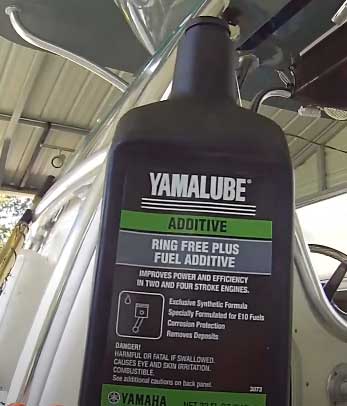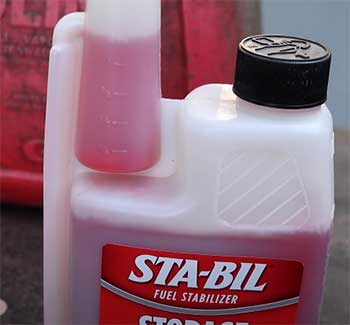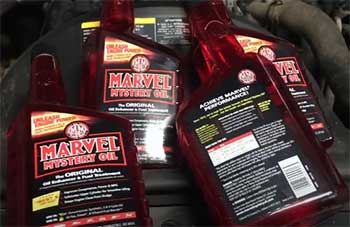Fuel stabilizers are crucial products for anyone who stores gasoline-powered equipment like boats, motorcycles, ATVs, RVs, generators, lawn tools, and more.
When gasoline sits untouched for weeks or months at a time, it starts to degrade, which can lead to a number of problems – hard starting, rough running, lost power, clogged injectors, and more.
Fuel stabilizers are chemical additives that help prevent the oxidation and breakdown of gasoline components. They keep fuel fresh and ready to use whenever you need it – even after extended storage. This saves you from headaches associated with stale, unusable gas.
Two of the leading brands in fuel stabilization are Yamaha and STA-BIL. Yamaha makes a proprietary stabilizer designed specifically for use in Yamaha engines. STA-BIL offers a diverse line of stabilizers suitable for all makes and models of engines.
This comprehensive guide will examine Yamaha and STA-BIL fuel stabilizers in detail. We’ll compare product features, real world performance, cost, availability, and proper usage recommendations. Let’s dive in and find the right stabilizer for your needs.
A Brief Comparison Table
| Aspects | Yamaha Fuel Stabilizer | STA-BIL |
| Purpose | For Yamaha engines | For all engines |
| Volume | 12 oz | 32 oz |
| Treats | 24 gallons | 80 gallons |
| Form | Liquid | Liquid |
| Key Ingredients | Proprietary formula | Hydrocarbon stabilizers, corrosion inhibitors |
| Duration | 1 year | 1 year |
| Ethanol Protection | Yes | Yes |
| Cost Per Gallon | $0.42-$0.83 | $0.13-$0.19 |
| Usage | Every fill up or storage | Every fill up or storage |
| Manufacturing | Japan | USA |
| Reviews | 4.5/5 stars (limited) | 4.7/5 stars |
Overview of Yamaha Fuel Stabilizer

Yamaha Marine produces their own proprietary fuel stabilizer designed specifically for Yamaha outboard motors and personal watercraft.
It meets the strict engineering requirements set by Yamaha for use in their fuel systems.
Here are some key benefits and features of Yamaha fuel stabilizer:
- Made for Yamaha Engines
The Yamaha fuel stabilizer formula is tailored for the specific materials and components used in Yamaha outboard motors.
For example, it contains lubricity agents ideal for Yamaha o-rings, gaskets, and injectors. Using the OEM-approved stabilizer ensures full compatibility.
- Prevents Ethanol Damage
Today’s E10 gasoline containing 10% ethanol can cause major issues for marine engines, including corrosion, leaks, clogs, and poor performance. Yamaha fuel stabilizer has special additives to protect against ethanol-related breakdown.
- Stabilizes Fuel for 12 Months
Yamaha’s stabilizer keeps fuel fresh and usable for up to one year when in storage or the tank. It slows oxidation and evaporation to prevent gasoline from going bad. This allows for easy starts and smooth operation even after sitting for months.
- Cleans Injectors
The Yamaha formula helps keep injectors clean from deposits that can distort spray patterns and reduce power. Injector clogs are a common problem with today’s ethanol fuel. The stabilizer helps preserve injector health.
- Adds Lubricity
Some of the lighter elements that evaporate from gasoline in storage are important for lubricating fuel system components. Yamaha’s stabilizer replaces this lost lubricity for items like o-rings, valves, and seals that rely on fuel for lubrication.
- Prevents Phase Separation
The stabilizer emulsifies water and ethanol, preventing them from separating out and causing phase separation problems common in boat fuel tanks.
- Exceeds Yamaha Standards
Yamaha fuel stabilizer exceeds all the performance specifications set by Yamaha engineering for use in Yamaha outboards and personal watercraft. This gives peace of mind the OEM-approved product will fully maintain your Yamaha engine.
Yamaha fuel stabilizer comes in 10 ounce bottles, with each bottle designed to treat 25 gallons of gasoline. One bottle is sufficient to treat the entire fuel tank of most small to mid-sized single outboards.
It’s readily available online or at most Yamaha marine dealers and retailers that carry Yamaha engine accessories and parts.
Now that we’ve covered the benefits of Yamaha’s stabilizer, let’s look at the popular STA-BIL fuel stabilizer line.
Overview of STA-BIL Fuel Stabilizer
STA-BIL is one of the most prominent fuel stabilizer brands, offering a full line of stabilizer products for all different types of engines and equipment. Some of the main features and benefits of STA-BIL fuel stabilizer include:

- Universal Application
STA-BIL makes stabilizer formulas suitable for any gas engine – outboards, motorcycles, classic cars, ATVs, snowmobiles, lawnmowers, chainsaws, generators, and more.
This universal application makes it very convenient.
- Proprietary Formulation
STA-BIL uses their own proprietary blend of additives including antioxidants, deicing agents, and corrosion inhibitors to stabilize fuel.
The exact formula is a trade secret.
- Stabilizes Fuel for Up to 2 Years
STA-BIL stabilizer keeps gasoline fresh and potent for up to 24 months when in proper storage conditions, extending shelf life considerably over untreated pump gas.
- Cleans Fuel System
In addition to stabilizing fuel, STA-BIL also helps remove deposits like gum, varnish, and corrosion as you run your engine. This keeps intake tracts clean for optimal efficiency.
- Prevents Ethanol Damage
Like the Yamaha product, STA-BIL stabilizer protects against phase separation and corrosion caused by ethanol-blended fuels, a critical benefit for marine engines, classic cars, and powersports vehicles.
- Improves Power & Performance
By reducing deposits and keeping fuel potent, STA-BIL can help restore lost power and performance in engines suffering from previous fuel issues like bad gas or clogged injectors.
- Variety of Sizes
STA-BIL comes in sizes ranging from 2.5 ounces treating 5 gallons of fuel up to 128 ounces treating 640 gallons. This allows easy treatment of small or large volume tanks with no mixing or measuring required.
Within the STA-BIL family, there are a few different formulas tailored for specific applications:
STA-BIL 360° Marine – Designed for boats, this provides maximum stabilization and ethanol protection for marine engines.
STA-BIL 360° Powersports & Racing – Intended for motorcycles, ATVs, RVs, snowmobiles and racing vehicles. Restores throttle response and horsepower.
STA-BIL 360° Performance – For classic and collector cars, it eliminates stalls, surges, and hesitation during startups and operation.
STA-BIL 360° All Season – An affordable general stabilizer for all gas-powered equipment like lawnmowers, generators, etc.
STA-BIL 360° Fuel Storage – The highest concentration designed for long term fuel storage of 1-2 years.
This range of formulas and sizes makes STA-BIL very versatile for all engines and equipment. Now let’s compare the real-world performance of Yamaha vs. STA-BIL fuel stabilizers.
Comparing Real-World Performance
There are a few key performance criteria we can look at to see how Yamaha and STA-BIL stabilizers stack up against each other in real world conditions:
- Stabilizing Ability
The most basic function of any fuel stabilizer is being able to keep fuel fresh during storage. Both Yamaha and STA-BIL are proven to prevent gasoline breakdown for extended periods.
Yamaha states their stabilizer protects fuel for up to 12 months in storage. STA-BIL advertises up to 24 months of protection. In practical use, both seem to work well for typical storage times of 6 months or less.
For very long term storage beyond a year, STA-BIL may offer somewhat longer lasting stabilization. But both are vastly better than untreated pump gas that can go bad in as little as 30 days.
- Ethanol Tolerance

With the prevalence of ethanol-blended fuels, tolerance to ethanol is hugely important, especially for marine engines.
Ethanol can cause corrosion, separation, clogs, leaks, and performance issues if not properly stabilized.
Both Yamaha and STA-BIL stabilizers utilize special additives to counteract common ethanol problems.
However, since Yamaha’s formula is engineered specifically for use in Yamaha outboards running ethanol fuel, it likely has the edge for marine applications.
But both seem highly effective at allowing proper ethanol compatibility.
- Cleaning and Lubrication
In addition to stabilizing fuel, good stabilizers also provide cleaning and lubrication benefits. Yamaha fuel stabilizer shines here – its formula cleans Yamaha injectors and lubricates internal fuel system components.
STA-BIL also offers proven cleaning properties to remove deposits over time.
When used in Yamaha engines, the OEM Yamaha stabilizer probably has superior cleaning and lubrication abilities tailored for the specific materials and parts used in Yamaha powerheads. But STA-BIL still offers solid performance in this category for most engines.
- Convenience
One clear advantage of STA-BIL is the wide range of size options available, from tiny 2.5 ounce bottles to large 128 ounce jugs. This allows easily treating anything from a motorcycle tank up to large diesel storage tanks. The single 10 ounce size of the Yamaha stabilizer is a bit less convenient.
STA-BIL also has broader availability, found virtually anywhere engine products are sold. Yamaha stabilizer tends to be limited to Yamaha dealerships and marine retailers catering specifically to boaters.
- Value
Both products deliver good value considering the amount of fuel they treat. Yamaha stabilizer costs around $15 for 10 ounces treating 25 gallons – about 60 cents per gallon stabilized.
STA-BIL ranges from $5 to $50 depending on size, working out to 30-90 cents per gallon treated on average. For larger quantities, STA-BIL provides very economical stabilization.
Now that we’ve compared some key performance and usage factors, let’s discuss recommendations for choosing between the two brands.
Also Read: Comparison of Ethanol Shield And STA-BIL Fuel Stabilizers.
Recommendations for Usage
When deciding between Yamaha and STA-BIL fuel stabilizers, there are a few simple rules of thumb to follow:
For Yamaha engines, use the Yamaha OEM stabilizer. It’s formulated to provide peak stabilization, lubrication, and cleaning for Yamaha powerheads. Using the manufacturer-approved stabilizer gives confidence you’re fully protecting your outboard or personal watercraft.
For other marine engines, STA-BIL Marine Formula is the top choice. Though not specially designed for boats like the Yamaha product, it still provides excellent ethanol protection and fuel stabilization for marine environments.
For motorcycles, ATVs, RVs, snowmobiles, the STA-BIL Powersports formula is specifically designed for optimal stabilization and performance in motor-powered recreational vehicles.
For seasonal lawn equipment, generators, etc, STA-BIL All Season formula provides affordable, easy stabilization for small engines used intermittently year-round.
For classic cars or long term storage beyond 1 year, go with STA-BIL Fuel Storage formula to get the longest lasting stabilization and corrosion prevention.
For small fuel tanks, the tiny 2.5 oz STA-BIL bottles allow easy treatment without having to measure – just dump in the whole bottle.
For large volume storage or diesel, the 128 oz STA-BIL jugs offer very economical stabilization for big fuel tanks up to 640 gallons.
When in doubt, you can’t go wrong with STA-BIL Marine for marine engines or STA-BIL All Season for everything else. These universal formulas work great for most common stabilization needs.
The most important thing is to use Yamaha or STA-BIL stabilizers as directed. Adding the proper dose to fresh gasoline will provide long-term fuel stabilization that can prevent numerous issues caused by spoiled fuel. Never let untreated gasoline sit – stabilizing additives are cheap engine insurance.
Now let’s recap some of the key questions consumers have about fuel stabilizers.
What Causes Gasoline To Go Bad In Storage?
Before we look closely at fuel stabilizers, it helps to understand what causes gasoline degradation in the first place when left sitting over time. There are a few key factors at play:
- Oxidation – Gas exposed to oxygen in the air oxidizes, breaking down its hydrocarbons into organic acids, peroxides, gums, and varnishes. This leaves decayed, unstable fuel.
- Evaporation – Lighter elements like pentane and butane evaporate out, altering the volatility of the gasoline. This affects vaporization inside the engine.
- Phase Separation – Ethanol blended fuel can separate, leaving water, ethanol, and gasoline layers. The water leads to corrosion.
- Thermal Breakdown – Heat accelerates the oxidation process, causing faster destabilization of molecules.
- Microbial Contamination – Yeasts and bacteria can grow in the water found in untreated gas tanks. They form biomass deposits.
- Sunlight Degradation – UV rays help break hydrocarbon chains down through a process called photo-oxidation.
These factors make gasoline go stale in as little as 30 days. Fuel stabilizers counteract these issues, keeping fuel potent and usable for 12-24 months in storage. Now let’s see how two top options – Yamaha and STA-BIL – stack up.
Also Read: Techron High Mileage Or Complete Fuel System Cleaner To Get?
Frequently Asked Questions (FAQ)
For Yamaha outboards, the OEM Yamaha stabilizer is recommended. For other marine and powersports engines, STA-BIL Marine and Powersports formulas edge out the competition. For small outdoor equipment, any STA-BIL product will excel.
STA-BIL Marine formula is the top choice for most boaters due to its ethanol protection and easy availability. Yamaha owners may prefer the OEM stabilizer engineered specifically for Yamaha engines.
Yes, STA-BIL Marine is an excellent stabilizer for all boat fuel tanks. It will keep your gas fresh for quick, reliable starts even after sitting for months.
You cannot overdose fuel by adding too much stabilizer – it will simply treat more fuel than intended. To avoid waste, follow the recommended dosage on the container. Excess stabilizer does not harm engines.
Both Yamaha and STA-BIL stabilizers keep fuel potent for 12-24 months when stored properly in sealed containers. Always add the proper dose of stabilizer to fresh gasoline for maximum longevity.
The Bottom Line
Yamaha and STA-BIL both produce high quality fuel stabilizers proven to extend gasoline shelf life and prevent engine issues caused by bad gas. Choosing between them comes down to a few key factors:
Use Yamaha stabilizer religiously for Yamaha engines – it’s formulated specifically for optimal performance and protection.
Choose STA-BIL for convenience and value – with more sizes and broader availability, it’s easier to find and economical to use.
Stabilize all stored gasoline – regardless of brand, fuel stabilizers are vital for storage of boats, classic cars, motorcycles, ATVs, RVs, generators and all gas-powered equipment.
Don’t take chances with stale, unstable gasoline ruining internal engine components. Regular use of Yamaha or STA-BIL fuel stabilizers will keep your fuel tanks fresh and your engines running smoothly all season.

